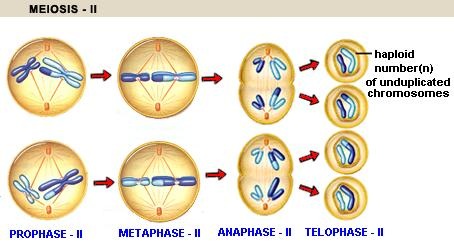- Meiosis is a type of cell division that occurs in sexually reproducing organisms. It involves two rounds of division, but only one round of DNA replication.
- Meiosis results in four haploid cells (half the chromosomes of a regular, or diploid cell).
1. Interphase: Chromosomes replicate, the same as mitosis.
2. Meiosis I: Meiosis I is very similar to that of Mitosis. The result of Meiosis I is two daughter diploid cells with chromatids that include region of nonsister DNA, which produces genetic variation.
2. Meiosis I: Meiosis I is very similar to that of Mitosis. The result of Meiosis I is two daughter diploid cells with chromatids that include region of nonsister DNA, which produces genetic variation.
|
3. Meiosis II: The result of Meiosis II is two haploid cells from each diploid cell created in Meiosis I, forming a total of four distinct daughter cells from the original cell. The haploid cells are distinct due to the crossing over in Prophase I, and each cell has only half the cells of the original cell (the definition of haploid).
|
It is important to remember that four daughter cells are produced, versus the two produced in mitosis. The crossing over that occurs during meiosis makes each daughter cell unique. In addition, the same process of cell division occurs in each division, and the division is similar to that of mitosis. Chromosomes are only replicated once, and one diploid cell produces four haploid cells.
To review the cell cycle, mitosis, meiosis, and the distinction between sexual and asexual reproduction, bozemanbiology on YouTube has a great video (x):
To review the cell cycle, mitosis, meiosis, and the distinction between sexual and asexual reproduction, bozemanbiology on YouTube has a great video (x):


